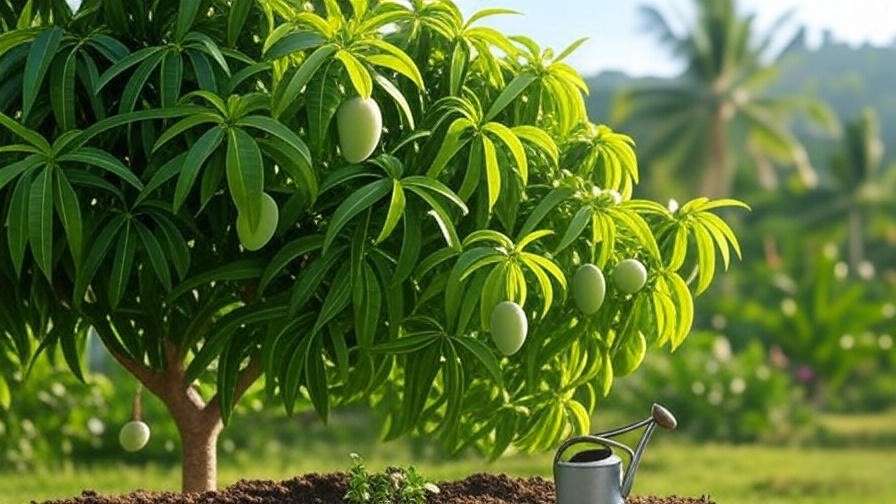Picture this: a lush, vibrant mango tree in your backyard, heavy with juicy, sun-ripened fruit, ready to be plucked and enjoyed. Sounds like a tropical dream, right? Yet, many gardeners struggle with sparse yields or unhealthy trees, wondering where they went wrong. Whether you’re a beginner or a seasoned grower, mango tree care is the key to transforming that dream into reality. With the right knowledge, you can nurture a thriving mango tree that produces bountiful, delicious fruit year after year. In this comprehensive guide, we’ll share seven expert-backed tips to boost your tree’s growth and maximize its yield, drawing on decades of horticultural expertise in tropical fruit cultivation. Get ready to dig in and grow your best mango tree yet! 🌞
Understanding Mango Trees: The Basics 🌿
Mango trees (Mangifera indica) are tropical evergreens that can live for decades, producing sweet, succulent fruit that’s a favorite worldwide. But to thrive, they need specific conditions and care tailored to their unique biology. Let’s break down what makes these trees special and why proper care is non-negotiable.
What Makes Mango Trees Unique?
Mango trees are native to South Asia but have spread to tropical and subtropical regions globally. They can grow 30-100 feet tall, with dense, glossy foliage and deep root systems. Popular varieties like Alphonso, Kent, and Tommy Atkins each have distinct flavors and growth habits, but all require warm climates (USDA zones 10-11), ample sunlight, and well-draining soil. According to the University of Florida’s Institute of Food and Agricultural Sciences, mango trees thrive in temperatures between 70-85°F, with minimal tolerance for frost. Choosing a variety suited to your region is the first step to success.
Why Proper Care Is Critical
Neglecting mango tree care can lead to stunted growth, poor fruit quality, or even tree loss. Common mistakes—like overwatering, improper pruning, or nutrient deficiencies—can weaken your tree and invite pests or diseases. On the flip side, consistent, informed care promotes vigorous growth, abundant blooms, and high-quality fruit. Dr. Jonathan Crane, a tropical fruit expert, notes, “Mango trees reward patience and precision with unmatched productivity.” By understanding their needs, you set the stage for a thriving tree.
Tip 1 – Choosing the Right Location and Soil 🏡
The foundation of successful mango tree care starts with where and how you plant. A well-chosen location and proper soil prep can make or break your tree’s health.
Ideal Climate and Sunlight
Mango trees crave full sun—6 to 8 hours daily—to fuel photosynthesis and fruit production. They flourish in warm, frost-free climates, ideally in USDA zones 10-11. If you’re in a borderline zone (e.g., 9b), create a microclimate by planting near a south-facing wall to trap heat or using frost blankets during cold snaps. Avoid shady spots or areas prone to waterlogging, as these stress the tree and stunt growth.
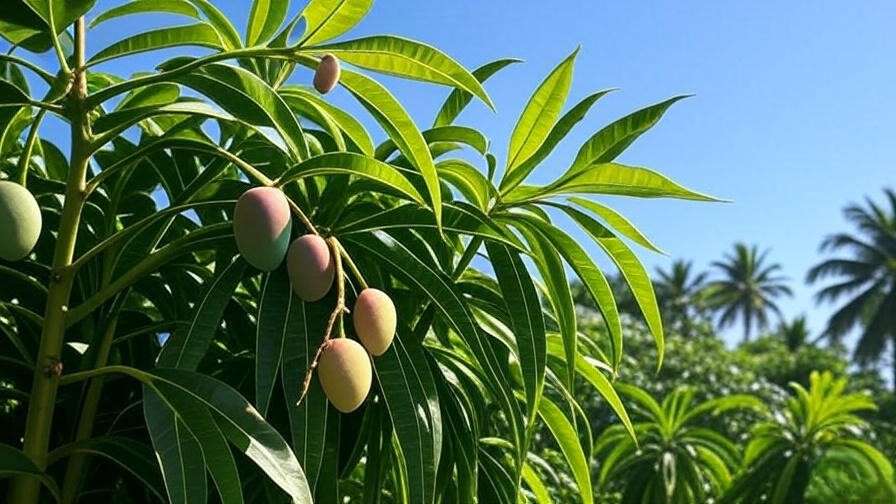
Soil Requirements for Optimal Growth
Mangoes prefer well-draining, loamy soil with a pH of 5.5-7.5. Heavy clay or sandy soils can hinder root development, so test your soil with a home kit or send a sample to a local extension service. Amend clay soils with organic matter like compost to improve drainage, and add sand to overly dense soils. A balanced soil mix ensures roots access nutrients without sitting in water. Pro Tip: Dig a hole twice as wide as the root ball and mix in 20% compost to give your tree a nutrient-rich start.
Tip 2 – Planting Your Mango Tree Correctly 🌱
Planting sets the tone for your tree’s long-term health. Done right, it ensures strong roots and early vigor.
When and How to Plant
The best time to plant mango trees is in spring or early summer, when warm temperatures encourage root establishment. Dig a hole 2-3 times wider than the root ball but no deeper than its height to avoid burying the trunk. Gently loosen the roots, place the tree in the hole, and backfill with a mix of native soil and compost. Water thoroughly and stake if needed to stabilize against wind. Space trees 15-25 feet apart to allow for canopy growth.
Grafted vs. Seed-Grown Trees
Grafted mango trees are the gold standard for home growers. They fruit in 3-5 years, compared to 7-10 years for seed-grown trees, and are bred for disease resistance and consistent fruit quality. Seed-grown trees, while fun for experimentation, often produce unpredictable fruit and take longer to mature. For reliable results, choose a grafted tree from a reputable nursery. Success Story: Sarah, a Florida gardener, planted a grafted Kent mango tree and harvested her first crop in just three years by following proper planting techniques.
Tip 3 – Watering Wisely for Healthy Growth 💧
Watering is a balancing act—too much or too little can harm your mango tree. Tailor your approach to the tree’s age and local conditions.
Watering Needs by Tree Age
Young mango trees (1-3 years) need frequent, shallow watering—about 2-3 times per week—to establish roots. Use 1-2 gallons per session, ensuring the soil stays moist but not soggy. Mature trees require deeper, less frequent watering (once every 1-2 weeks), using 5-10 gallons to encourage deep root growth. Adjust based on rainfall: reduce watering during wet seasons to prevent root rot.
Avoiding Overwatering and Underwatering
Overwatering shows up as yellowing leaves or fungal growth, while underwatering causes wilting or leaf drop. Check soil moisture by digging 2 inches down; water only if it’s dry. Mulch with 2-3 inches of organic material (like wood chips) to retain moisture and reduce evaporation. Expert Tip: Install a drip irrigation system for consistent, efficient watering, especially in dry climates.
Tip 4 – Fertilizing for Vigorous Growth and Fruiting 🍃
Fertilization fuels your mango tree’s growth and fruit production, but it’s easy to overdo. Here’s how to get it right.
Nutrient Needs of Mango Trees
Mangoes need a balanced mix of nitrogen (for foliage), phosphorus (for roots and flowers), and potassium (for fruit quality). Micronutrients like zinc and magnesium are also critical for preventing deficiencies that cause poor fruiting. A 10-10-10 NPK fertilizer works well for young trees, while fruiting trees benefit from a 6-6-12 formula with added micronutrients.
When and How to Fertilize
Fertilize young trees every 2-3 months during the growing season (spring to summer) with 1-2 pounds of fertilizer, spread evenly under the canopy. For mature trees, apply 3-4 pounds twice yearly—once in early spring and again after harvest. Always water deeply after fertilizing to prevent root burn. DIY Recipe: Mix 50% compost, 25% aged manure, and 25% bone meal for an organic fertilizer that boosts soil health.
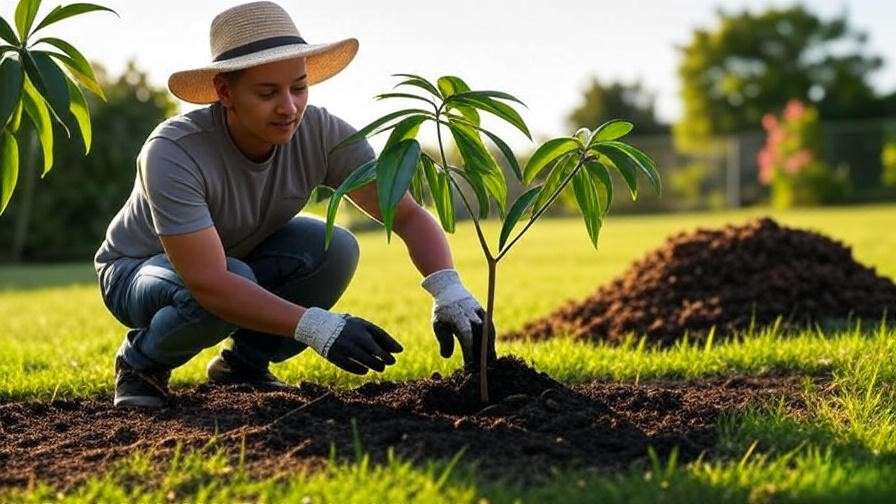
Tip 5 – Pruning for Structure and Productivity ✂️
Pruning is a cornerstone of mango tree care, shaping your tree for optimal health and fruit production. Done correctly, it enhances airflow, sunlight penetration, and fruit accessibility while reducing disease risk.
Why Pruning Matters
Mango trees can grow dense canopies that block light and trap moisture, inviting fungal issues like anthracnose. Regular pruning maintains an open structure, promotes flowering, and makes harvesting easier. For young trees, pruning establishes a strong framework; for mature trees, it sustains productivity. According to the University of California’s Agriculture and Natural Resources, proper pruning can increase fruit yield by up to 20% by improving light exposure to inner branches.
Pruning Techniques and Timing
Prune in late winter or post-harvest, when the tree is dormant, to minimize stress. For young trees (1-3 years), focus on shaping: remove suckers, crossing branches, and inward-growing shoots to create a balanced canopy with 3-5 main branches. For mature trees, thin out crowded areas and cut back excessive growth to maintain a height of 10-15 feet for easy harvesting. Use clean, sharp tools and make angled cuts just above a bud. Visual Aid: Imagine a V-shaped cut above an outward-facing bud to direct growth outward, as shown in pruning diagrams from extension services.
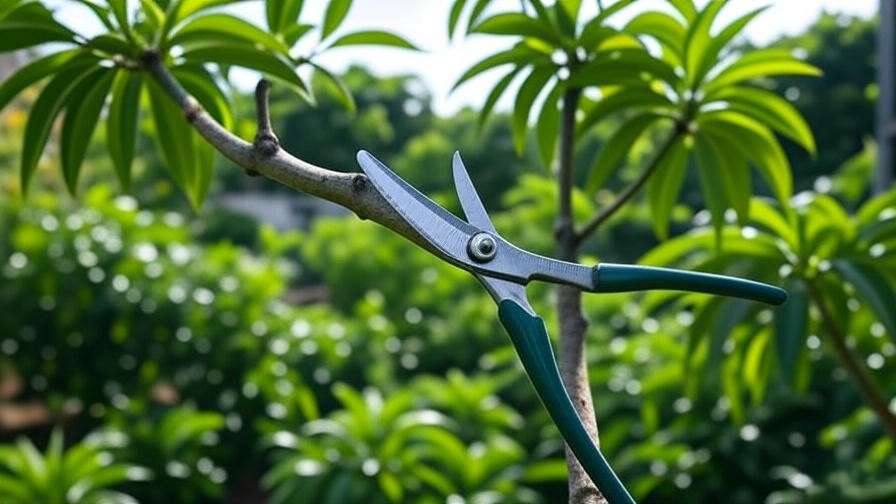
Tip 6 – Pest and Disease Management 🐞
Pests and diseases can derail your mango tree’s health, but proactive management keeps them at bay. Integrated pest management (IPM) combines cultural, organic, and chemical strategies for sustainable control.
Common Pests and How to Control Them
Mango trees face threats from pests like fruit flies, scale insects, and mealybugs. Fruit flies lay eggs in ripening fruit, causing rot; use sticky traps or organic baits like protein hydrolysate to control them. Scale insects suck sap, weakening branches—apply neem oil weekly or introduce natural predators like ladybugs. Regular inspection is key: check leaves and stems for sticky residue or small, waxy bumps. Pro Tip: Spray a mix of 1 tablespoon neem oil, 1 teaspoon dish soap, and 1 gallon water for an effective, organic pest deterrent.
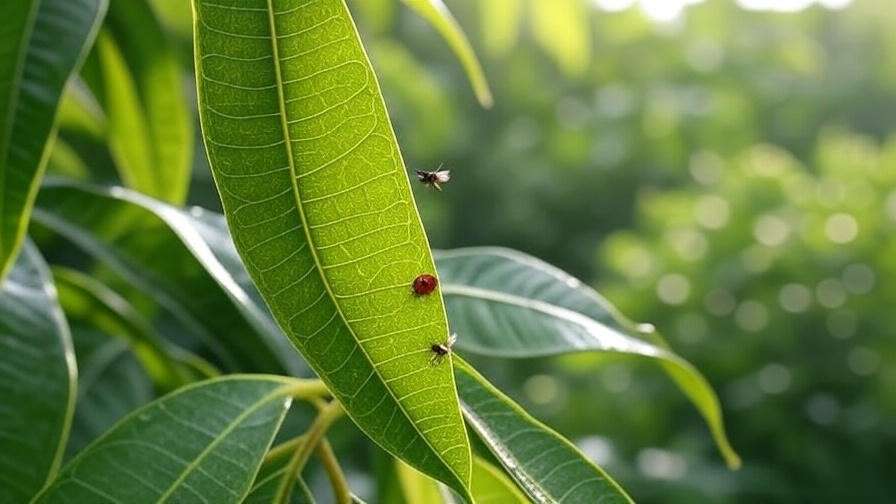
Preventing and Treating Diseases
Fungal diseases like anthracnose and powdery mildew are common in humid climates. Anthracnose causes black spots on leaves and fruit, while powdery mildew coats leaves in white residue. Prevent these by ensuring good airflow through pruning and avoiding overhead watering. If disease appears, apply a copper-based fungicide every 10-14 days during wet seasons, following label instructions. Dr. Maria Lopez, a plant pathologist, emphasizes, “Sanitation is critical—remove fallen leaves and fruit to break the disease cycle.” Regularly clean tools and debris to maintain a healthy growing environment.
Tip 7 – Maximizing Fruit Yield and Quality 🍋
The ultimate goal of mango tree care is a bountiful harvest of sweet, juicy fruit. These strategies will help you maximize both quantity and quality.
Encouraging Flowering and Fruit Set
Mango trees need specific conditions to bloom reliably. In some cases, mild stress—like reducing water for 4-6 weeks in late fall—can trigger flowering by signaling the tree to reproduce. Ensure adequate potassium and micronutrients during bloom season to support flower development. Pollination is critical: attract bees with nearby wildflowers or hand-pollinate by brushing flowers with a soft paintbrush. Quick Tip: Plant companion flowers like marigolds to boost pollinator activity around your tree.
Harvesting at the Right Time
Mangoes are ready to harvest when they reach full size, develop a slight yellow blush, and feel slightly soft to the touch. Cut fruit with a 1-inch stem to avoid sap burn, which can damage skin. Store at room temperature until fully ripened, then refrigerate for up to two weeks. Success Story: John, a home grower in Hawaii, doubled his yield from 20 to 45 mangoes per season by timing harvests and optimizing pollination, proving these techniques work.
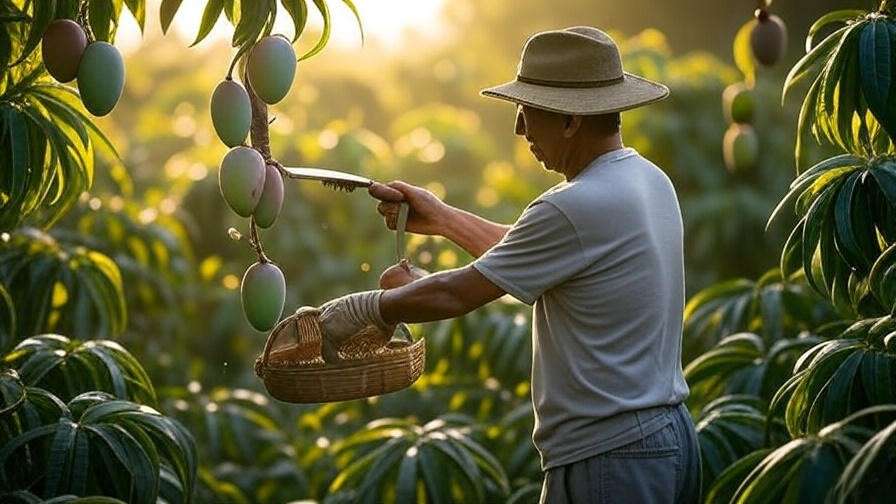
Troubleshooting Common Mango Tree Problems 🛠️
Even with the best care, issues can arise. Here’s how to diagnose and fix common mango tree challenges.
Why Isn’t My Tree Fruiting?
Lack of fruit can stem from several issues:
- Young Age: Grafted trees fruit in 3-5 years; seed-grown trees take longer.
- Nutrient Imbalance: Excess nitrogen promotes leafy growth over flowers—switch to a low-nitrogen, high-potassium fertilizer.
- Improper Pruning: Over-pruning can remove flower buds; follow the pruning guide above.
- Environmental Stress: Cold or drought can inhibit blooming. Address these with protective measures like frost cloths or consistent watering.
Test soil and adjust care to encourage flowering next season.
Dealing with Environmental Stress
Mango trees are sensitive to extreme weather. For cold snaps, cover young trees with frost blankets or burlap. During droughts, mulch heavily and water deeply every 10 days. In high winds, stake young trees or plant windbreaks like hedges. Checklist:
- Monitor weather forecasts for frost or heatwaves.
- Apply 4-6 inches of mulch to insulate roots.
- Use shade cloth for young trees during intense summer heat.
Seasonal Mango Tree Care Calendar 📅
Consistency is key to mango tree success. This year-round guide keeps your tree thriving.
Year-Round Maintenance Guide
- Spring: Fertilize with a balanced NPK mix; prune lightly to shape young trees; water young trees 2-3 times weekly.
- Summer: Monitor for pests; water mature trees every 1-2 weeks; apply mulch to retain moisture.
- Fall: Reduce watering to induce flowering (if needed); fertilize fruiting trees post-harvest.
- Winter: Prune mature trees; protect from frost; check soil drainage before rainy seasons.
Adjust based on your region—coastal areas may need less frost protection, while inland zones require extra care.
Preparing for Extreme Weather
Storms or freezes can damage mango trees. Before storms, secure loose branches and stake young trees. For freezes, wrap trunks in burlap and mound soil around the base to insulate roots. Resource: Download a printable mango tree care calendar from [insert website link] to stay on track.
FAQs About Mango Tree Care ❓
Q1: How long does it take for a mango tree to bear fruit?
A: Grafted trees typically fruit in 3-5 years, while seed-grown trees may take 7-10 years. Proper care speeds this up.
Q2: Can mango trees grow in pots?
A: Yes, dwarf varieties like ‘Carrie’ thrive in large pots (20+ gallons) with well-draining soil and full sun. Repot every 2-3 years.
Q3: What’s the best way to protect my tree from pests organically?
A: Use neem oil sprays, introduce beneficial insects, and maintain tree health through proper watering and pruning.
Q4: How do I know if my mango tree is healthy?
A: Look for glossy green leaves, steady growth, and no signs of pests or disease. Yellowing or wilting indicates stress—check water and nutrients.
Conclusion: Your Path to a Thriving Mango Tree 🌟
Growing a mango tree that bursts with fruit is within your reach. By choosing the right location, planting correctly, watering wisely, fertilizing strategically, pruning thoughtfully, managing pests, and optimizing fruit set, you’ll unlock your tree’s full potential. These seven tips, grounded in decades of horticultural research and real-world success, empower you to cultivate a healthy, productive mango tree. Start small, stay consistent, and savor the journey to your own tropical harvest. Share your mango tree success stories in the comments or join our gardening community at [insert website link]. Happy growing! 🌴

